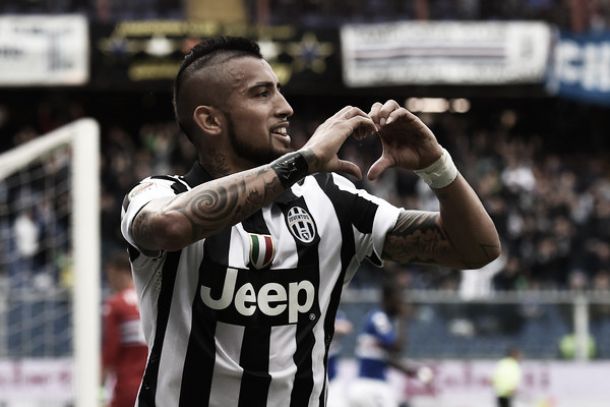In the 2014-2015 season, Arsene Wenger’s formation of choice with Arsenal was a 4-1-4-1. This is similar to a 4-3-3 and similar to a 4-5-1 but with key, distinguishable, discernible differences.
In comparison to the traditional 4-3-3, the midfield in a 4-1-4-1 is more staggered meaning that there are layers to the structure in the middle of the park. Furthermore, the wide players are more midfielders than they are wingers; the left midfielder and right midfielder in Wenger’s 4-1-4-1 are expected to come into midfield and act more like wide playmakers whereas the 4-3-3 has wingers that act in support of the focal point; the striker. Where the 4-1-4-1 differs from the 4-5-1 is that it is far less defensive and more reliant on an anchor, on a singular pivot in the midfield, a role played by Coquelin to great success in the second half of the season.
No change
Vidal could slot into the 4-1-4-1 that Wenger looks to prefer in two different positions. Firstly, he could play as one of the two central midfielders in front of the central defensive midfielder. This would be a natural position for Vidal where his incredible engine, incisive passing and excellent attacking movement would see him play an integral role as a box-to-box midfielder, key in the transition from attack to defence.
Less naturally, Vidal could occupy the position of the central defensive midfielder, although this is a role he would have to be forced to play rather than one that is of choice. He has the ability in possession to perform this role, the tough-tackling and aerial strength to be dominant as an enforcer in the middle of the park but that position would require Vidal to make a conscious effort throughout the 90 minutes of a football match to curb his attacking instincts. It was a role he played in his Bayer Leverkusen days but not a role he has played regularly in four seasons with Juventus.
Adaptation
Wenger could adapt the formation to become a 4-2-3-1, where Vidal would be placed next to a defensive midfielder in the midfield duo. This formation requires at least one absolute defensive midfielder and then a man next to him to partake in the attacking build-up. Look at title-winners Chelsea in the 2014-2015 season; Nemanja Matic took up the role as the ball winner in midfield and ex-Arsenal man Cesc Fabregas took the role of the deep-lying playmaker and the two formed a successful partnership.
Wenger has used the 4-2-3-1 at times this season although it has been a hybrid of that formation with the 4-1-4-1 rather than a pure 4-2-3-1. Formations do not have to be rigid though, and require some sort of dynamism to break down opponents who look to have it sussed out. When Wenger has rolled out a 4-2-3-1, Santi Cazorla has played very well as the deep-lying playmaker, as the ball-player next to the ball-winner of Coquelin. However, Cazorla isn’t getting any younger and at 30 years of age, is reported to be nearing a move back to his homeland of Spain, namely to Atletico Madrid; could Wenger replace the Spaniard with La Roja's Vidal?
Diamond
The 4-1-4-1 and 4-2-3-1 are essentially variants of the well-known 4-3-3 and Wenger may choose to apply a different formation entirely should Vidal become an Arsenal player. A midfield diamond could be a formation of choice; a formation that very nearly took the Premier League title to Liverpool in the 2013-2014 under the stewardship of Brendan Rodgers and led by the ingenuity of Uruguayan Luis Suarez.
A sugar-and-spice combination of Olivier Giroud and Alexis Sanchez as the two strikers, with Mesut Özil in behind as the number "10" and then a midfield trio could be employed. Coquelin would take his place as the central defensive midfielder, and could be partnered in the midfield by Vidal and one of Ramsey or Jack Wilshere. The midfield diamond of Coquelin, Ramsey/Wilshire, Vidal and Ozil could prove to be very tempting for Wenger indeed.
Vidal’s versatility combined with his ability makes him a player that will be in high demand should Juventus make the decision to sell. However, with Vidal in some trouble following a DUI arrest and questions over his professionalism as well as the fact Vidal would be an expensive buy at the relatively old 28 years of age, should Wenger buy him? Or should Wenger keep his trust in the midfield options he has at his disposable and not take the gamble of trying out a new system?
Vidal becoming an Arsenal player would not force Wenger to change formation; it would, however, provide more options to use. Whatever Wenger decides or whatever happens, Arsenal fans should look on with keen interest.










































